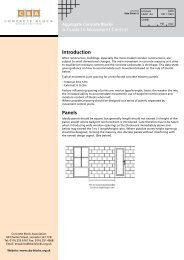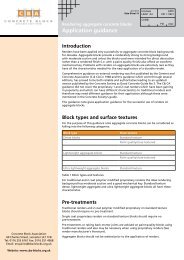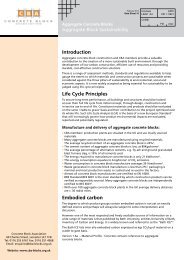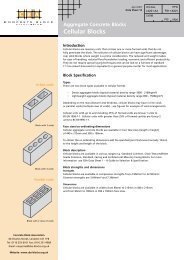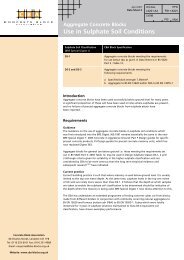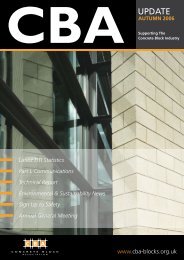Understanding BS EN 771-3: Aggregate concrete masonry units
Understanding BS EN 771-3: Aggregate concrete masonry units
Understanding BS EN 771-3: Aggregate concrete masonry units
- No tags were found...
Create successful ePaper yourself
Turn your PDF publications into a flip-book with our unique Google optimized e-Paper software.
60 Charles Street, Leicester LE1 1FBTel: 0116 253 6161 Fax: 0116 251 4568Email: enquiries@cba-blocks.org.uk Website: www.cba-blocks.org.ukFebruary 2006<strong>Understanding</strong> <strong>BS</strong> <strong>EN</strong> <strong>771</strong>-3: <strong>Aggregate</strong><strong>concrete</strong> <strong>masonry</strong> <strong>units</strong>Important guidance for specifiers and users on a new Standardfor aggregate <strong>concrete</strong> blocksIntroduction<strong>BS</strong> <strong>EN</strong> <strong>771</strong>-3: <strong>Aggregate</strong> <strong>concrete</strong> <strong>masonry</strong> <strong>units</strong> (Dense and lightweightaggregates) is a new harmonized Standard for aggregate <strong>concrete</strong> bricksand blocks. It will replace <strong>BS</strong> 6073-1 in April 2006 after a 12-month periodof co-existence.There is no doubt that over a period of 24 years <strong>BS</strong> 6073-1 has served ourindustry well in developing concise and unambiguous specifications foraggregate <strong>concrete</strong> bricks and blocks used in far ranging applications.Like most British Standards it has been necessary to adapt <strong>BS</strong> 6073-1 tosuit an enlarged market as well as to reflect up to date materials testing andregulatory requirements.This Guide to <strong>BS</strong> <strong>EN</strong> <strong>771</strong>-3: has been prepared to assist anyone involved inthe design, specification and ordering of aggregate <strong>concrete</strong> blocks to understandthe changes and thereby continue to make the specification and procurementof aggregate <strong>concrete</strong> blocks as straightforward as possible.Background<strong>BS</strong> <strong>EN</strong> <strong>771</strong>-3 <strong>Aggregate</strong> <strong>concrete</strong> <strong>masonry</strong> <strong>units</strong> is written as a performancestandard which means that all requirements are based on the finished product,rather than prescriptive standards which limit the materials that can be usedin manufacture.• Unlike <strong>BS</strong> 6073, <strong>BS</strong> <strong>EN</strong> <strong>771</strong>-3 requires a manufacturer to conduct limited typetesting and have a documented factory production control system. A thirdparty to monitor the factory production control system is not essential.• The test methods for the required properties are listed in <strong>BS</strong> <strong>EN</strong> <strong>771</strong>-3.Some of these test methods are familiar but others are new.1
• Groupings of <strong>units</strong> are introduced.• Categories of <strong>units</strong> are introduced.• It contains a national foreword and a national annex, which between themexplain the essential differences between <strong>BS</strong> 6073 and <strong>BS</strong> <strong>EN</strong> <strong>771</strong>-3.Requirements• DimensionsThese have to be declared in the order: Length, width & height. (e.g. 440mmx 100mm x 215mm). This is an important distinction between the previouscustom of specifying and ordering blocks based on dimensions in the orderof length x height x width (thickness).<strong>BS</strong> <strong>EN</strong> <strong>771</strong>-3 gives 4 tolerance classes (D1, D2, D3 & D4). Class D1(+3, -5mm on all dimensions) is the most appropriate for common blockapplications. Tolerance D4 is intended solely for blocks to be laid with thinjoint mortar, a technique rarely used in the UK.Closer tolerances on any dimension may also be declared by themanufacturer for any tolerance category.The test method for dimensions is <strong>BS</strong> <strong>EN</strong> 772-16.• ConfigurationReference is made to the requirements of the groupings of <strong>units</strong> used in theEuropean Masonry Design Code (<strong>BS</strong> <strong>EN</strong> 1996-1-1).<strong>BS</strong> <strong>EN</strong> 1996-1-1 puts lower limits on:Shell thicknessWeb thicknessbut these limits are generally much lower than used in current UK designsand are normally easily complied with using current aggregate block products.<strong>BS</strong> <strong>EN</strong> 1996-1-1 also categorizes <strong>units</strong> according to void percentages asfollows:Group 1Group 2Group 3Group 4< 25% formed vertical voids by volume> 25% < 60% formed vertical voids by volume> 25% < 70% formed vertical voids by volume> 25% < 50% formed horizontal voids by volume2
See Annex A for full details of the requirements for unit groupings.Blocks currently described as ‘solid’ will become Group 1 <strong>units</strong>. Cellular andhollow blocks will, depending on void content, will be described as Group 1or 2 <strong>units</strong>. Group 3 and 4 <strong>units</strong> are not commonly manufactured for use inthe UK.Configuration also covers flatness requirements for the faces of facing quality<strong>units</strong> only, and flatness requirements for the bed surfaces of <strong>units</strong> to be usedwith thin layer mortar in D4 tolerance category.There is also a requirement for the parallelism of bed faces of <strong>units</strong> to beused with thin layer mortar in conjunction with the D4 tolerance category.For facing <strong>units</strong> there is an optional but strongly recommended procedurefor the site approval of the appearance of unit prior to their use.• DensityThe gross dry density of the blocks has to be declared by the manufacturer.The standard also requires net dry density to be given when it is relevantto the application. The net dry density is rarely likely to be a necessity inpractice.A density tolerance of + or – 10% is allowed on both gross and net density.The appropriate test method is <strong>BS</strong> <strong>EN</strong> 772-13.The compressive strength will need to be declared air dry. The conditioningand surface preparation used need to be declared by the manufacturer.The appropriate test method is <strong>BS</strong> <strong>EN</strong> 772-1.Annex B gives new strengths referred to in Building Regulations and BritishStandards. These are slightly higher than strengths determined to <strong>BS</strong> 6073.The manufacturer will declare whether a unit is category I or category II.A category I unit would be approximately equivalent to special categoryas defined in <strong>BS</strong> 5628-1 and would require third party certification andmonitoring of the production control system.• Thermal propertiesIn the UK, configuration and density is used primarily as the basis for thedeclaration of thermal properties. Manufacturers will still be allowed to givethermal resistance values of products using values from CI<strong>BS</strong>E Guide A.(For cellular/hollow <strong>units</strong> the thermal resistance can be calculated to<strong>BS</strong> <strong>EN</strong> ISO 6946 taking off the surface resistance values).3
• DurabilityGenerally durability compliance criteria are to be found in <strong>BS</strong> 5628-3.• Water absorption by capillarityWater absorption is only applicable to facing <strong>units</strong> with no applied finish.The appropriate test method is <strong>BS</strong> <strong>EN</strong> 772-11, (Clay and aircrete <strong>units</strong>use the same test method but using different procedures within themethod and these will lead to test results for the products, which cannotbe directly compared).• Moisture movementThis will now be declared to a new test method, which is a combination ofdrying shrinkage and wetting expansion.The appropriate test method is <strong>BS</strong> <strong>EN</strong> 772-14 (Aircrete is tested to<strong>BS</strong> <strong>EN</strong> 680 and this will lead to lower values which cannot be compareddirectly with results to <strong>BS</strong> <strong>EN</strong> 772-14).• Water vapour permeabilityTabulated values are likely to be declared in accordance <strong>BS</strong> <strong>EN</strong> 1745,<strong>BS</strong> 5250 & CI<strong>BS</strong>E Guide Book. If tested, values can be determined to<strong>BS</strong> <strong>EN</strong> ISO 12572.• Reaction to fire (spread of flame)If the manufacturer uses materials that result in a unit containing more than1% by mass or volume of organic material then he is responsible for thefollowing tests to be carried out:<strong>BS</strong> <strong>EN</strong> ISO 1182 Reaction to fire tests for building materials.Non- combustibility test.<strong>BS</strong> <strong>EN</strong> ISO 1716 Reaction to fire test for building materials – Determination ofthe heat of combustion.And the results need to be classified according to <strong>BS</strong> <strong>EN</strong> 13501-1.• Shear bond strengthA value of shear bond strength needs to be given and it is recommended thatthe tabulated value of 0.15 N/mm from Annex C of <strong>BS</strong> <strong>EN</strong> 998-2 is declared.(The tabulated value or a measured value is of no practical use as bondstrength in practice will be dependent on a number of factors outside thecontrol of the producer and a value could not be guaranteed as beinguniversally applicable, but only for a set of specific conditions, which wouldbe difficult to replicate on site).4
• Flexural bond strengthThis requirement only applies in Finland and therefore a value need not begiven as there is no regulatory requirement for this property to be declaredin the UK.• ClassificationThere are no classification systems for <strong>masonry</strong> <strong>units</strong> in the UK but thereare in some EU countries.• MarkingIt is anticipated that product identification details and means of identificationof the date of manufacture will be given on delivery documentation and onthe product where appropriate.5
Annex AGroupings of <strong>concrete</strong> <strong>units</strong> from <strong>EN</strong> 1996-1-1Volume of allholes (% ofthe grossvolume)Group 1(all materials)Limits for Masonry UnitsGroup 2 Group 3 Group 4HorizontalVertical HolesHoles< 25 > 25; < 60 > 25; < 70 > 25; < 50Volume ofany hole (%of the grossvolume)< 12,5Each ofmultiple holes 18 > 15 > 15 > 20 > 20Declaredvalue ofcombinedthickness (a)(b)of websand shells(% of theoverall width)NoRequirement> 18 > 15 > 45a) The combined thickness is the thickness of the webs and shells, measuredhorizontally across the unit at right angles to the face of the wall. The check is tobe seen as a qualification test and need only be repeated in the case of principalchanges to the design dimensions of <strong>units</strong>.b) In the case of conical holes, or cellular holes, use the mean of the thickness ofthe webs and the shells.6
Annex BCompressive strength of <strong>units</strong>To <strong>BS</strong> 6073-1 To <strong>BS</strong> <strong>EN</strong> <strong>771</strong>-32.82.93.53.65.05.27.07.310.010.4Preferred higher unit compressive strengths<strong>BS</strong> 5628-1: 1992<strong>BS</strong> 5628-2: 2000152035<strong>BS</strong> 5628-1: 2005<strong>BS</strong> 5628-2: 2005(Not equivalent to 1992 &2000 strengths)17.522.530.040.0To order a copy of the full standards please visit: www.bsonline.bsi-global.com7




